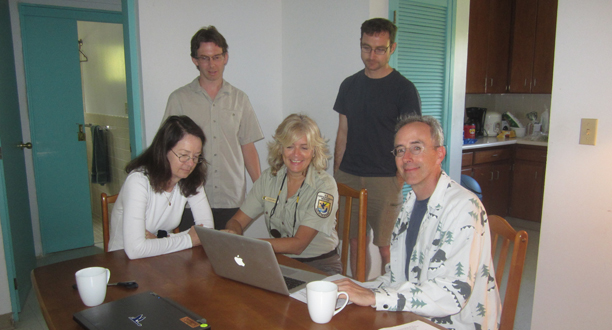The Mariana Trench Monument

“Holy smokes!” Peering alongside Dr. Doug Bartlett at his computer screen, I was introduced to the 20-cm-long amphipods discovered on the DEEPSEA CHALLENGER dive to 27,000 feet in the New Britain Trench. The picture showed big, white, shrimp-looking creatures that were discovered at their deepest range last week. The amphipods I knew of before this moment were smaller, one- to two-cm cousins. Dr. Patty Fryer commented, “That’s quite a food source.” Raising the unspoken question, “For what … at that depth?”
So began my primer to the fantastical curiosities and discoveries that are all but assured by the DEEPSEA CHALLENGE expedition.
I arrived in Guam two nights ago from the U.S. Fish and Wildlife Service Marianas Trench Marine National Monument headquarters in Honolulu, Hawai`i. As the superintendent of the Trench Monument, I was invited to witness the Guam preparations of the expedition and to ensure their planning is in accordance with the conservation management of the monument.
Months ago, scientists from the DEEPSEA CHALLENGE project contacted my office for permission to explore and film in the national monument. After receiving their applications, and because the monument area they want to work is also managed as a unit of the U.S. National Wildlife Refuge System, we undertook a deliberative resource management process to ensure proposed exploration is compatible with the purposes of the monument and refuge. Monument management partners from the National Oceanic and Atmospheric Administration, including experts on deep-sea environments, were also consulted to review compatibility determinations and applications and help shape the special use permits.
Throughout the permitting process one strong theme was glaringly apparent to me: This is a science expedition, and it is developed by people who value the natural and wild deep-sea world and its conservation. As leading experts of the deep sea, they welcomed monument managers’ concerns and remedies for possible environmental impacts from the expedition. They provided conservation-supporting scientific publications examining the effects of man on the deep sea and suggested practices to minimize potential effects into the future of exploration.
At the start of my second day here today I take stock: I’ve been briefed by the science team about the unmanned landers’ design and capabilities for exploration, discovery, and monitoring the bottom of the Earth; and also about the targeted areas for exploring. Today, the landers and the submersible will be further explained to me. Yesterday I met and spoke with Jim Cameron and I can’t help but liken him to a James Audubon of the deep—bringing the wonders of deep nature to the world through his own eyes, spinning visions of his experiences in our heads through his masterful storytelling and expert filmmaking. He appears to me an explorer, a naturalist, an inventor, and an interpreter impassioned by his craft. I forget he is the guy who has made some of my favorite movies.
Being here, Cameron and the entire team reinforce my earlier observations, and I am gratified to realize their support of the conservation management of this most unique national treasure—the Trench Monument. They see that conservation of this area is as important as designating the Grand Canyon as a national monument was more than a hundred years ago. They also see beyond the unknown and imagine the possibilities the Trench Monument holds for understanding our world a hundred years from now. They want to make future generations curious and inquisitive of what lies beyond the abyss. Technology and novel engineering is opening up the deep-sea environments to facilitate that understanding, and it is now imaginable that the deep seas can be as accessible to people in the future as the skies are to us today. As all this comes together today though, I am reminded that it is really a timely endeavor to protect ecosystems before they are damaged or lost, or need repair and restoration. I believe President Bush, buoyed by the support for conservation by thousands of people in the Mariana Islands, had that vision when he protected the Mariana Trench as a national monument in 2009.
The book is yet to be written on the things we don’t know today about the deep-sea environment. Science is just beginning to “scratch the surface” of the bottom. New creatures, features, and processes have unfolded with every expedition, and their protection in the Trench National Monument is assured in the future with our effective management. But this expedition is changing the mold because the dives of the DEEPSEA CHALLENGER will be witnessed—with a full range of emotions—by a human being. A human being who is able to describe and inspire us about nature’s treasures at the bottom of the sea and about how one feels when introduced to them. I can’t help but think, Wow, welcome to the future.
Susan White is the Monuments Superintendent / Refuge Project Leader for the Pacific Reefs National Wildlife Refuge Complex, U.S. Fish & Wildlife Service



